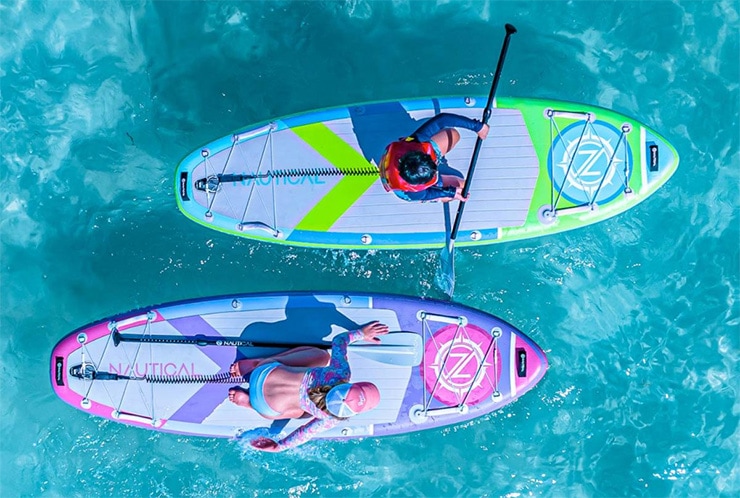Since SUP boarding is done on water, you can almost be sure that your paddle will end up in the water at some point. You may fall in and let it go or it could accidentally slip from your hand.
So this raises the question, do paddle board paddles float?
It helps to know, so you won’t lose your precious paddle – good ones aren’t particularly cheap.
Now, the answer to this question is not a simple yes or no. Some SUP paddles float, others don’t.
Let’s get into the details so you know whether or not your paddle will float.
Different Paddle Materials: Which Ones Float?
The material used to make your SUP paddle may make it sink or float. It’s important to take a look at what your paddle is made of, and to know the different materials that go into making paddle board paddles (whether buoyant or not).
The type of paddle blade can also have an impact– as well as the blade size, but the shaft is usually more important. Having a plastic blade (which is light) wouldn’t matter if the shaft is made of heavy aluminum, for example.
Let’s take a closer look at the different paddle materials.
Aluminum Paddles
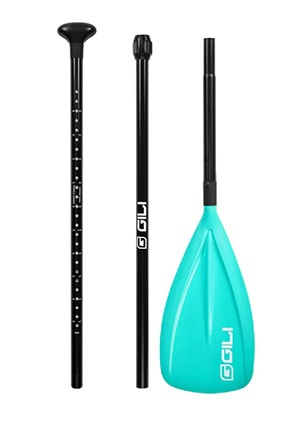
Aluminum is a common material for making paddles and most budget SUPs come with an aluminum paddle.
It’s affordable and works well for paddling but it can be a little heavy. Also, aluminum sinks in water. So if you have an aluminum paddle it will probably not float.
However, some aluminum paddles have a hollow shaft, which can make a difference.
With the shaft hollow and full of air, the overall density becomes less than that of water. That could prevent your aluminum paddle from sinking–as long as water doesn’t make it into the paddle shaft (more on this in a second).
Today, many aluminum paddles also contain foam elements, and they will stay afloat until you retrieve them. Other manufacturers go a step further and include a padded float on the lower part of the shaft. If your paddle’s shaft has this padding, you have nothing to worry about. It will float.
Plastic Paddles
Plastic is mainly used to make paddle blades. Full plastic paddles are not common-maybe in kids’ paddles. But a plastic paddle blade is quite common.
A solid plastic paddle would not float in water.
Fiberglass Paddles
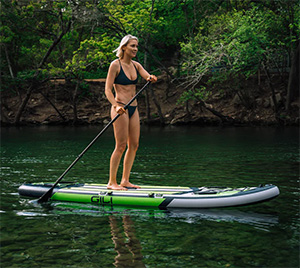
A fiberglass paddle is much better than an aluminum paddle in that it’s lighter and more efficient for paddle boarding.
It’s mainly used to make paddle shafts and the paddle’s blade will most likely be made of plastic.
Fiberglass is denser than water so it doesn’t float. However, like aluminum paddles, they have a hollow shaft which makes them buoyant. They also have foam in the shaft and this allows them to float.
Wooden Paddles
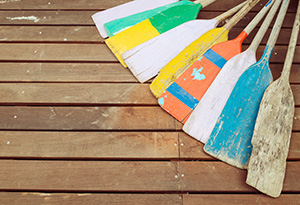
Wooden paddles aren’t particularly common. They are usually preferred by paddlers who want a unique paddle with an authentic feel–and are not generally used as a primary paddle.
Wood floats because it’s less dense than water so your wooden paddle will most likely float if you drop it in the water.
However, it really depends on the type of wood and its density compared to that of water. If it’s denser it might sink.
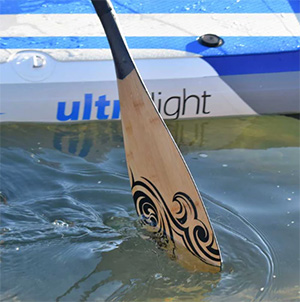
Carbon Fiber Paddles
Carbon fiber paddles are premium quality and their cost reflects that.
A carbon fiber paddle is stiffer and more efficient than a fiberglass paddle.
Most of them are also extremely lightweight, making them fun to use.
In addition to being lighter, carbon fiber paddles are also hollow and feature a foam insert so they’ll float.
Single-Piece Vs Multiple Piece Paddles: Does It Affect the Floating Capability?
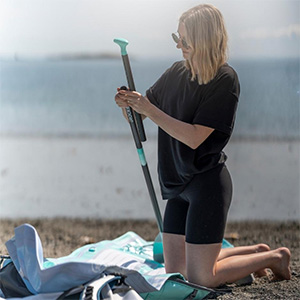
Other than the SUP paddle material, the shaft design also determines whether or not it will float.
Stand up paddle board paddles can either be single-piece or multiple pieces. A single-piece paddle has a shaft made up of one piece of sealed hollow material. Two-, three-, or four-piece paddles, on the other hand, have a shaft made up of more than one piece.
Multiple-piece paddles can be taken apart for storage, then assembled again when you want to use the paddle. The paddle length is also adjustable. This means that there are “joints” where the pieces connect to each other.
If the paddle construction is poor, these joints may not be quite airtight. And even in a well-made paddle, the connecting areas may weaken over time. This causes the paddle shaft to take in water, losing its buoyancy.
A fixed-length paddle may not allow you to enjoy the benefits of adjustable length but it’s airtight and this will maintain buoyancy.
Frequently Asked Questions
Do SUP Paddle Board Paddles Sink?
No, most paddle board paddles do not sink. It depends on the material used to make the paddle and the shaft design.
Many paddles have a hollow shaft, which will make them float, regardless of the material used to make them. Manufacturers also include a foam core to help with buoyancy. So you can expect most paddles to float. And even if it sinks, it won’t be rapid so you may have time to retrieve it before it’s lost forever.
Another thing, if the shaft is air-tight and doesn’t take on water then the paddle will float. But if water gets in the shaft then you’ll notice the SUP board paddle start to sink.
How Do I Keep My Paddle from Sinking?
If you’ve noticed that your paddle sinks, one solution would be to buy a paddle float. It’s made of foam and you slip it on the paddle shaft to give your paddle buoyancy.
Another option would be to get a paddle leash. Like the leash for your paddle board, a paddle leash ensures that your leash is attached to you at all times. So if it falls in or you fall in, you don’t have to worry about it sinking to the bottom.
Conclusion
Some paddle materials float on water while others don’t. Manufacturers often counter this by making the shaft hollow. This creates an air pocket that makes the paddle buoyant. Paddles may also have a foam insert which makes them buoyant.
However, if it’s a multiple-piece paddle this buoyancy might be compromised if the connecting points allow water into the shaft.
It’s always a good idea to test whether your paddle floats first before going paddle boarding with it. This way, if it doesn’t you can get a paddle float or paddle leash.

